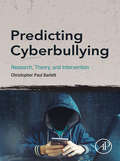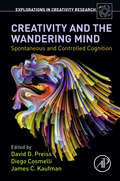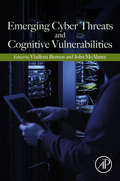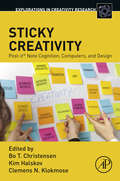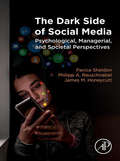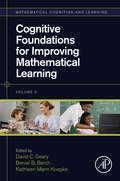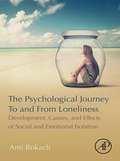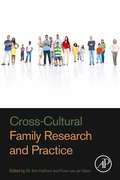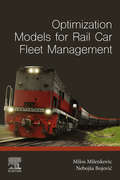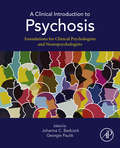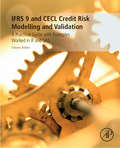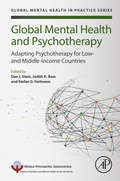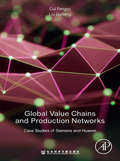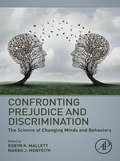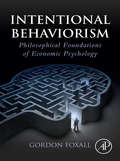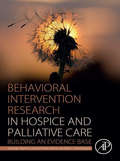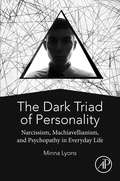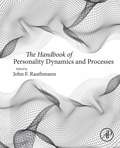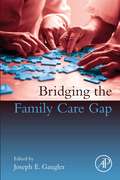- Table View
- List View
Predicting Cyberbullying: Research, Theory, and Intervention
by Christopher Paul BarlettPredicting Cyberbullying: Research, Theory, and Intervention delves into the theoretical advances that have been made to predict cyberbullying perpetration. It examines myriad psychological- and communication-based theories, discusses the relevant research to support (or not) each theory, and elucidates the strengths and limitations of these theories. Moreover, the book differentiates cyberbullying from traditional bullying to expand on a theory that takes such differences into account to predict perpetration. In addition, it adapts interventions to address these nuanced theoretical advancements and concludes with an examination of validated psychological theories that can inform interventions and reduce cyberbullying. The book is an effective and concise reference for psychologists, school administrators, counselors and psychological researchers looking to understand theory and interventions for cyberbullies.Focuses on the cyberbully perpetrator Balances theory with interventional applicationsIdentifies key risk factors in those who cyberbullyExplores the scope of theoretically driven hypotheses specific to cyberbullying
Handbook of Green Economics
by Sevil Acar Erinç YeldanHandbook of Green Economics reveals the breadth and depth of advanced research on sustainability and growth, also identifying opportunities for future developments. Through its multidimensional examination, it demonstrates how overarching concepts, such as green growth, low carbon economy, circular economy and others work together. Some chapters reflect on different discourses on the green economy, including pro-growth perspectives and transformative approaches that entail de-growth. Others argue that green policies can spark economic innovation, particularly in developing and emerging market economies. Part literature summary, part analysis and part argument, this book shows how the right conditions can stimulate economic growth while achieving environmental sustainability. This book will be a valuable resource for graduate students and academic researchers whose focus is on the green economy. With an increasing interest in the topic among researchers and policymakers, users will find different theoretical perspectives and explore policy implications in this growing subject area.Covers the failures of the past, the challenges of the present, and the opportunities of the futureSurveys 10 aspects of the green economy, including conceptualization, natural capital, poverty and inequality, welfare, and financeEmphasizes the theoretical and empirical aspects of greening approaches that are policy-relevant
Creativity and the Wandering Mind: Spontaneous and Controlled Cognition (Explorations in Creativity Research)
by James C. Kaufman David D. Preiss Diego CosmelliCreativity and the Wandering Mind: Spontaneous and Controlled Cognition summarizes research on the impact of mind wandering and cognitive control on creativity, including imagination, fantasy and play. Most coverage in this area has either focused on the negative consequences of mind wandering on focused problem solving or the positive effect of mindfulness, but not on the positive consequences of mind wandering. This volume bridges that gap. Research indicates that most people experience mind wandering during a large percentage of their waking time, and that it is a baseline default mode of brain function during the awake but resting state. This volume explores the different kinds of mind wandering and its positive impact on imagination, play, problem-solving, and creative production. Discusses spontaneous and controlled processes in creativityExamines the relationship between mind wandering, consciousness, and imaginationReviews research on problem-solving, imagination, play, and learningHighlights the positive impact of mind wandering on creative thought and output
Emerging Cyber Threats and Cognitive Vulnerabilities
by Vladlena Benson John McalaneyEmerging Cyber Threats and Cognitive Vulnerabilities identifies the critical role human behavior plays in cybersecurity and provides insights into how human decision-making can help address rising volumes of cyberthreats. The book examines the role of psychology in cybersecurity by addressing each actor involved in the process: hackers, targets, cybersecurity practitioners and the wider social context in which these groups operate. It applies psychological factors such as motivations, group processes and decision-making heuristics that may lead individuals to underestimate risk. The goal of this understanding is to more quickly identify threat and create early education and prevention strategies. This book covers a variety of topics and addresses different challenges in response to changes in the ways in to study various areas of decision-making, behavior, artificial intelligence, and human interaction in relation to cybersecurity.Explains psychological factors inherent in machine learning and artificial intelligenceDiscusses the social psychology of online radicalism and terrorist recruitmentExamines the motivation and decision-making of hackers and "hacktivists"Investigates the use of personality psychology to extract secure information from individuals
Sticky Creativity: Post-it® Note Cognition, Computers, and Design (Explorations in Creativity Research)
by Bo T. Christensen Kim Halskov Clemens N. KlokmoseSticky Creativity: Post-It® Note Cognition, Computers, and Design presents the interesting history of sticky notes and how they have become the most commonly used design material in brainstorming, business model generation, and design thinking. The book brings together researchers from psychology, computer science and design in order to understand why and how sticky notes are used, why they work well, and whether sticky notes are replaceable or improvable by a digital counterpart. The book covers psychology, computers and design respectively. From a psychological perspective, cognitive and socio-cognitive theories are used to explain the functions sticky notes serve in idea generation and creative collaboration. Following sections present the findings from three very different computerized instantiations of sticky notes and discuss the challenges and opportunities that arise when trying to digitize sticky notes. Highlights the benefits of sticky notes in idea generation and creative collaborationExplores the use of sticky notes in a variety of creative, design professional and educational settingsIncludes research perspectives from cognitive psychology, computer science and design studies
The Dark Side of Social Media: Psychological, Managerial, and Societal Perspectives
by James M. Honeycutt Pavica Sheldon Philipp RauschnabelThe Dark Side of Social Media: Psychological, Managerial, and Societal Perspectives examines how social media can negatively affect our lives. The book tackles issues related to social media such as emotional and mental health, shortened attention spans, selective self-presentation and narcissism, the declining quality of interpersonal relationships, privacy and security, cyberstalking, cyberbullying, misinformation and online deception, and negative peer effects. It goes on to discuss social media and companies (loss of power, challenging control mechanisms) and societies as a whole (fake news, chatbots, changes in the workplace). The Dark Side of Social Media: Psychological, Managerial, and Societal Perspectives empowers readers to have a more holistic understanding of the consequences of utilizing social media. It does not necessarily argue that social media is a bad development, but rather serves to complement the numerous empirical findings on the "bright side" of social media with a cautionary view on the negative developments.Focuses on interpersonal communication through social mediaFocuses on psychology of media effectsExplores social media issues on both an individual and societal levelDocuments the rise of social media from niche phenomenon to mass marketExamines the differences between creating and consuming content
Underwriting Commercial Real Estate in a Dynamic Market: Case Studies
by Christian RedfearnA recurrent theme in Underwriting Commercial Real Estate in a Dynamic Market is that good thinking and good underwriting go together. This stands in contrast with "getting an answer" or even worse "reverse engineering" – getting to a solution by assuming that current trends in market pricing is best. The cases in Underwriting Commercial Real Estate in a Dynamic Market will force readers to recognize that there is no single answer, but rather a range of answers that will depend on numerous perspectives. And, in order to make valuation decisions, they will have to undertake a rich conversation about what constitutes a good trade-off and what does not. Cases can be structured for use with introductory material as well as advanced topics.Encourages readers to think about alternatives and their viabilityAddresses real world variations and concentrates on large urban economic forces and their implications for real estate valuationPresents case studies that vary significantly in length and specificityIncludes pedagogical materials such as case introductions and exhibits
Cognitive Foundations for Improving Mathematical Learning (ISSN #Volume 5)
by David C. Geary Daniel B. Berch Kathleen Mann KoepkeThe fifth volume in the Mathematical Cognition and Learning series focuses on informal learning environments and other parental influences on numerical cognitive development and formal instructional interventions for improving mathematics learning and performance. The chapters cover the use of numerical play and games for improving foundational number knowledge as well as school math performance, the link between early math abilities and the approximate number system, and how families can help improve the early development of math skills. The book goes on to examine learning trajectories in early mathematics, the role of mathematical language in acquiring numeracy skills, evidence-based assessments of early math skills, approaches for intensifying early mathematics interventions, the use of analogies in mathematics instruction, schema-based diagrams for teaching ratios and proportions, the role of cognitive processes in treating mathematical learning difficulties, and addresses issues associated with intervention fadeout.Identifies the relative influence of school and family on math learningDiscusses the efficacy of numerical play for improvement in mathFeatures learning trajectories in mathExamines the role of math language in numeracy skillsIncludes assessments of math skillsExplores the role of cognition in treating math-based learning difficulties
Living with Robots: Emerging Issues on the Psychological and Social Implications of Robotics
by Richard Pak Ewart J. de Visser Ericka RoviraLiving with Robots: Emerging Issues on the Psychological and Social Implications of Robotics focuses on the issues that come to bear when humans interact and collaborate with robots. The book dives deeply into critical factors that impact how individuals interact with robots at home, work and play. It includes topics ranging from robot anthropomorphic design, degree of autonomy, trust, individual differences and machine learning. While other books focus on engineering capabilities or the highly conceptual, philosophical issues of human-robot interaction, this resource tackles the human elements at play in these interactions, which are essential if humans and robots are to coexist and collaborate effectively. Authored by key psychology robotics researchers, the book limits its focus to specifically those robots who are intended to interact with people, including technology such as drones, self-driving cars, and humanoid robots. Forward-looking, the book examines robots not as the novelty they used to be, but rather the practical idea of robots participating in our everyday lives. Explores how individual differences in cognitive abilities and personality influence human-robot interactionExamines the human response to robot autonomyIncludes tools and methods for the measurement of social emotion with robotsDelves into a broad range of domains - military, caregiving, toys, surgery, and moreAnticipates the issues we will encountering with robots in the next ten yearsForeword by Maggie Jackson
The Psychological Journey To and From Loneliness: Development, Causes, and Effects of Social and Emotional Isolation
by Ami RokachThere are three universal experiences that we cannot escape: loneliness, illness, and death. The Psychological Journey To and From Loneliness addresses what was termed the plague of the 21st century--loneliness. Loneliness is stigmatized in our society, so untold number of people walk around lonely, unable to do what is so naturally called for--make their suffering known, and approach others for company and support. Thankfully, loneliness is slowly, but steadily, coming out of the "closet." This book will highlight not only the experience and what can be done about it, but also the experiences that influence it (i.e., our childhood, cultural and religious influences, and our way of life) as well as the effects that loneliness has on various population groups and how it is experienced at different times in our lives. This volume reviews theoretical approaches to the study of loneliness: the (positive) functions that loneliness may serve in our lives; the stages in life when loneliness is quite "visible" and its effects on us; the life experiences that may strengthen the feeling that one is all alone and forgotten; life experiences that we do not commonly connect to loneliness but it is clearly present in them (e.g., pregnancy and childbirth); and the approaches that are available to copy with its pain and limit its negative effects on us. The book closes with a review of how psychotherapy can assist those who need encouragement and support in their struggle with loneliness. The book is particularly suitable for academics, researchers, and clinicians who aim to help clients identify, address, and cope with loneliness.Presents the latest research on the development, causes and effects of lonelinessStudies loneliness in childhood, adolescence, and middle and old ageOutlines what can be done to limit the negative effects of loneliness on an individualLooks at how childhood, cultural, religious and other influences affect loneliness
Cross-Cultural Family Research and Practice
by W. Kim Halford Fons van de VijverCross-Cultural Family Research and Practice broadens the theoretical and clinical perspectives on couple and family cross-cultural research with insights from a diverse set of disciplines, including psychology, sociology, communications, economics, and more. Examining topics such as family migration, acculturation and implications for clinical intervention, the book starts by providing an overarching conceptual framework, then moves into a comparison of countries and cultures, with an overview of cross-cultural studies of the family across nations from a range of specific disciplinary perspectives. Other sections focus on acculturation, migrating/migrated families and their descendants, and clinical practice with culturally diverse families.Studies cultural influences in couple and family relationshipsFeatures a broadly interdisciplinary perspectiveLooks at how cultural differences affect how families are structured and functionExplores why certain immigrant groups adapt better to new countries than othersDiscusses why certain countries are better at integrating immigrants than others
Untangling Smart Cities: From Utopian Dreams to Innovation Systems for a Technology-Enabled Urban Sustainability
by Mark Deakin Luca MoraUntangling Smart Cities: From Utopian Dreams to Innovation Systems for a Technology-Enabled Urban Sustainability helps all key stakeholders understand the complex and often conflicting nature of smart city research, offering valuable insights for designing and implementing strategies to improve the smart city decision-making processes. The book drives the reader to a better theoretical and practical comprehension of smart city development, beginning with a thorough and systematic analysis of the research literature published to date. It addition, it provides an in-depth understanding of the entire smart city knowledge domain, revealing a deeply rooted division in its cognitive-epistemological structure as identified by bibliometric insights. Users will find a book that fills the knowledge gap between theory and practice using case study research and empirical evidence drawn from cities considered leaders in innovative smart city practices. Provides clarity on smart city concepts and strategiesPresents a systematic literature analysis on the state-of-the-art of smart cities' research using bibliometrics combined with practical applicationsOffers a comprehensive and systematic analysis of smart cities research produced during its first three decadesGenerates a strong connection between theory and practice by providing the scientific knowledge necessary to approach the complex nature of smart cities Documents five main development pathways for smart cities development, serving the needs of city managers and policymakers with concrete advice and guidance
Optimization Models for Rail Car Fleet Management
by Milos Milenkovic Nebojsa BojovicOptimization Models for Rail Car Fleet Management represents the result of multi-year efforts to provide readers with insights into one of the most important areas of railway transport management. The book covers mathematical procedures for the effective and efficient utilization of railway freight cars, developed models for optimization methods, heterogeneity and partial substitutability of freight cars, research and development in rail freight car fleet management models, and the stochastic and dynamic nature of the supply, demand and traveling time of freight cars, among other topics.Summarizes the authors past research efforts in the field of rail freight car fleet managementPresents various approaches that include the application of a variety of optimization techniques Contains centralized, decentralized, distributed perspectives considered under the assumption of deterministic, stochastic, fuzzy and fuzzy stochastic parameters
A Clinical Introduction to Psychosis: Foundations for Clinical Psychologists and Neuropsychologists
by Johanna C. Badcock Georgie PaulikThis practical guide outlines the latest advances in understanding and treating psychotic symptoms and disorders, articulating step-by-step the clinical skills and knowledge required to effectively treat this patient population. A Clinical Introduction to Psychosis takes an evidence-based approach that encourages a wider perspective on clinical practice, with chapters covering stigma and bias, cultural factors, the importance of social functioning, physical health, sleep, and more. A broad array of treatment modalities are discussed, including cognitive behavioral therapy, cognitive remediation, psychosocial interventions, trauma-informed therapies, and recovery-oriented practice. The book also provides a concise overview of the latest advances regarding cognitive profiles in people with psychotic disorders, the developmental progression of cognitive abilities, and the clinical relevance of cognitive dysfunction. The book additionally familiarizes readers with issues and controversies surrounding diagnostic classification, transdiagnostic expression, and dimensional assessment of symptoms in psychosis.Provides treatment and assessment methods for psychotic symptoms and disordersLooks at how psychosis develops and the impact of stigma on clinicians and clientsStudies the links between trauma, PTSD, and psychosis, as well as sleep and psychosisCovers digital technologies for treating and assessing psychosisOutlines strategies for treating visual and auditory hallucinationsExamines how to incorporate consumer and clinician perspectives in clinical practice
IFRS 9 and CECL Credit Risk Modelling and Validation: A Practical Guide with Examples Worked in R and SAS
by Tiziano BelliniIFRS 9 and CECL Credit Risk Modelling and Validation covers a hot topic in risk management. Both IFRS 9 and CECL accounting standards require Banks to adopt a new perspective in assessing Expected Credit Losses. The book explores a wide range of models and corresponding validation procedures. The most traditional regression analyses pave the way to more innovative methods like machine learning, survival analysis, and competing risk modelling. Special attention is then devoted to scarce data and low default portfolios. A practical approach inspires the learning journey. In each section the theoretical dissertation is accompanied by Examples and Case Studies worked in R and SAS, the most widely used software packages used by practitioners in Credit Risk Management.Offers a broad survey that explains which models work best for mortgage, small business, cards, commercial real estate, commercial loans and other credit productsConcentrates on specific aspects of the modelling process by focusing on lifetime estimatesProvides an hands-on approach to enable readers to perform model development, validation and audit of credit risk models
Global Mental Health and Psychotherapy: Adapting Psychotherapy for Low- and Middle-Income Countries (Global Mental Health in Practice)
by Stefan G. Hofmann Dan J. Stein Judith K. BassGlobal Mental Health and Psychotherapy: Adapting Psychotherapy for Low- and Middle-Income Countries takes a detailed look at how psychotherapies can be adapted and implemented in low- and middle-income countries, while also illuminating the challenges and how to overcome them. The book addresses the conceptual framework underlying global mental health and psychotherapy, focusing on the importance of task-shifting, a common-elements approach, rigorous supervision, and the scaling up of psychotherapies. Specific psychotherapies, such as cognitive-behavioral therapy, interpersonal therapy and collaborative care are given in-depth coverage, as is working with special populations, such as children and adolescents, pregnant women, refugees, and the elderly. In addition, treatment strategies for common disorders, such as depression, anxiety and stress, and substance abuse are covered, as are strategies for more severe mental disorders, such as schizophrenia.Provides adapted psychotherapy strategies for low- and middle-income countriesLooks at special considerations for particular disorders and populationsCovers the treatment of both common and severe mental health problemsFocuses on task-shifting, a common-elements approach and scaling of psychotherapiesAddresses cognitive-behavioral therapy, interpersonal therapy and schema therapy
Global Value Chains and Production Networks: Case Studies of Siemens and Huawei
by Fengru Cui Guitang LiuGlobal Value Chains and Production Networks: Case Studies of Siemens and Huawei presents theories and frameworks that facilitate the evolution of GPN studies, from macro perspectives based on territory and industry to the use of micro (firm-level) data. The book explores these theories and frameworks through detailed case studies of two major corporations, Siemens and Huawei. With the GPN/GVC structure of Chinese firms not well known outside China, despite the growing importance of Chinese firms in the global economy, this guide plays a pivotal role in facilitating the use of data that promise to unlock economic cooperation and value.Emphasizes micro-data analytical models and their methodological underpinningsIllustrates how these data illuminate the economic structures of two comparable GPNs within highly divergent institutional contextsSuggests how companies can cooperate with foreign partners to enhance their global management capacity and reshape their advantages in international competition
Confronting Prejudice and Discrimination: The Science of Changing Minds and Behaviors
by Robyn K. Mallett Margo J. MonteithConfronting Prejudice and Discrimination: The Science of Changing Minds and Behaviors focuses on confrontation as a strategy for reducing bias and discrimination. The volume tackles questions that people face when they wish to confront bias: What factors influence people’s decisions to confront or ignore bias in its various forms? What are the motives and consequences of confrontation? How can confrontation be approached individually, through education and empowerment, and in specific contexts (e.g., health care) to yield favourable outcomes? These questions are paramount in contemporary society, where confrontation of bias is increasingly evident. Moreover, great strides in the scientific study of confrontation in the past 20 years has yielded valuable insights and answers. This volume is an essential resource for students and researchers with an interest in prejudice and prejudice reduction, and will also be valuable to non-academics who wish to stand up to bias through confrontation. Addresses factors that determine individuals’ decisions to confront stereotyping, prejudice and discriminationAnalyzes how personal and collective motives shape responses in confrontation-relevant situationsExamines the consequences of confrontation from the perspectives of targets, perpetrators and bystandersProvides a roadmap for how to prepare for and engage in successful confrontations at the individual levelCovers confronting bias in various settings including in schools, health care, the workplace and on the internetDiscusses confrontation in the context of racism, sexism, sexual harassment and other forms of bias, including intersectional forms of bias
The Handbook of Antagonism: Conceptualizations, Assessment, Consequences, and Treatment of the Low End of Agreeableness
by Donald Lynam Joshua W. MillerThe Handbook of Antagonism: Conceptualizations, Assessment, Consequences, and Treatment of the Low End of Agreeableness looks at the theoretical and empirical underpinnings of antagonism, highlighting the consequences of the trait, its role in a number of problem behaviors and psychiatric disorders, and how it exerts itself on externalizing behaviors. Covering the biological and evolutionary roots of antagonism, the book provides clinical insight on assessment strategies, while also outlining a number of treatment techniques, including motivational interviewing, cognitive behavioral therapy, interpersonal psychology and psychodynamic treatment approaches. In addition, the book explores the development of antagonism across childhood and adolescence, discussing the societal consequences of the trait, as well as its role in a number of problem behaviors, such as aggression, violence, crime and substance use. Provides an overview on the development, assessment and treatment of antagonismLooks at antagonism’s role in work, romantic relationships and other domainsOutlines self-report and non-self-report assessment approachesStudies the links between antagonism, psychopathy, narcissism and antisocial personalityApproaches antagonism from a dimensional trait modelAnalyzes the role antagonism plays in several prominent psychiatric disorders
Intentional Behaviorism: Philosophical Foundations of Economic Psychology
by Gordon FoxallIntentional behaviorism is a philosophy of psychology that seeks to ascertain the place and nature of cognitive explanation of behavior by empirically determining the scope of an extensional account of behavior based on the limitations of a behavioral approach to explanation. This book draws on an empirical program of research in economic psychology to establish a route to a reliable and justifiable intentional explanation of behavior. Since the cognitive revolution in psychology, intentional explanations of behavior have become the norm, and as the methodology that provides the normal science component of psychology, cognitivism is sometimes accepted relatively uncritically. However, there is a lack of understanding of the role of psychological research in determining the place and shape of intentionality. This book explicates the philosophy of psychology that the author has devised and applied in his work on economic psychology and behavioral economics. Given the provenance of intentional behaviorism, economic and consumer psychology forms the primary application basis for the book. This book provides a theoretical background to understanding how and why consumers make the choices they do. The book integrates behavioral economics, consumer psychology, and decision-making research to explore intentional behaviorism, which is proposed as a philosophical framework for consumer psychology, viewing economic behavior in the contexts of modern human consumers in affluent marketing-oriented societies.Integrates research in behavioral economics, decision-making, cognitive psychology, and consumer psychology.Offers readers an interdisciplinary look at intentionality and intentional explanations.Proposes a theory of intentional behaviorism to explain economic behavior, consumer choice, and other decision-making.Examines the methodologies of philosophers of mind such as Dennett and Searle.
Behavioral Intervention Research in Hospice and Palliative Care: Building an Evidence Base
by George Demiris Debra Parker Oliver Karla T. WashingtonBehavioral Intervention Research in Hospice and Palliative Care: Building an Evidence Base sets forth research considerations and guidelines to build evidence-based interventions to improve end-of-life care. It is an in-depth introduction to implementation research and showcases how a clinical need is identified to inform an intervention. The book extensively examines the various phases of intervention research, including design, implementation, evaluation, dissemination and translation. The book focuses on methodological, ethical and practical issues. The science behind the quality of hospice and palliative care lags behind that of traditional medical practice, despite the continuous growth of palliative care interdisciplinary teams. Researching, developing and testing strategies is essential to advancing the effectiveness and value of this care.Informs readers how to conduct intervention research toward identifying best careAdvises readers on design, implementation and evaluation of researchProvides step-by-step templates to develop an intervention studyIncludes mock protocols from successful intervention trialsSynthesizes lessons learned by established intervention researchers in hospice and palliative care
The Dark Triad of Personality: Narcissism, Machiavellianism, and Psychopathy in Everyday Life
by Minna LyonsThe Dark Triad of Personality: Narcissism, Machiavellianism, and Psychopathy in Everyday Life summarizes the latest research on how these personality traits (psychopathology, narcissism, Machiavellianism) are defined and displayed, while also exploring the impact they have on individuals and society, the relationship between clinical conditions and personality traits, and their adaptivity. The book introduces the Dark Triad through the lens of existing clinical and personality literature, discussing shared and unique cognitive and empathetic profiles associated with each trait. Antisocial, antagonistic, and criminal behaviors associated with the Dark Triad are also covered, as is the way these individuals compete socially and in the workplace. Reviews the development, measurement and evolutionary origins of these traitsExplores how these traits may be adaptiveAssesses the relationship between clinical conditions and Dark Triad personality traitsIncludes sections on manipulation, competition and cooperation
The Handbook of Personality Dynamics and Processes
by John F. RauthmannThe Handbook of Personality Dynamics and Processes is a primer to the basic and most important concepts, theories, methods, empirical findings, and applications of personality dynamics and processes. This book details how personality psychology has evolved from descriptive research to a more explanatory and dynamic science of personality, thus bridging structure- and process-based approaches, and it also reflects personality psychology’s interest in the dynamic organization and interplay of thoughts, feelings, desires, and actions within persons who are always embedded into social, cultural and historic contexts. The Handbook of Personality Dynamics and Processes tackles each topic with a range of methods geared towards assessing and analyzing their dynamic nature, such as ecological momentary sampling of personality manifestations in real-life; dynamic modeling of time-series or longitudinal personality data; network modeling and simulation; and systems-theoretical models of dynamic processes. Ties topics and methods together for a more dynamic understanding of personalitySummarizes existing knowledge and insights of personality dynamics and processesCovers a broad compilation of cutting-edge insightsAddresses the biophysiological and social mechanisms underlying the expression and effects of personalityExamines within-person consistency and variability
Bridging the Family Care Gap
by Joseph E. GauglerBridging the Family Care Gap explores expected future shortages of family caregivers of older persons and identifies potential solutions. The book examines the sustainability and availability of care management models and whether they can be effectively scaled up to meet community needs. It identifies newly emerging policy initiatives at local, state, and federal levels. The book addresses the state of family caregiving science, dissemination and implementation of promising programs and supports, technological innovations, and other strategies to offset the family care gap. This edited volume also explores lay healthcare workers as guides, interpreters, and advocates in healthcare systems that provide continuity of contact for family caregivers.Details threats to family caregiving-sociodemographic, chronic disease, and socioeconomic challengesPresents solutions to the caregiving gap in a systematic, synthesized mannerAddresses the intersection of family caregiving and technologyDiscusses chronic disease management to offset and reduce the need for family caregivingDescribes models of caregiver support in work settingsReimagines the delivery of long-term services and supports with novel initiatives
Creativity and Humor (Explorations in Creativity Research)
by James C. Kaufman John Baer Sarah R. LuriaCreativity and Humor provides an overview of the intersection of how humor influences creativity and how creativity can affect humor. The book's chapters speak to the wide reach of creativity and humor with different topics, such as play, culture, work, education, therapy, and social justice covered. As creativity and humor are individual traits and abilities that have each been studied in psychology, this book presents the latest information. Explains how, and why, humor enhances creativityExplores the thought processes behind producing humor and creativityExamines how childhood play is the basis for both creativity and humorDiscusses cross-cultural differences in humor and creativityReviews creativity and humor in politics, teaching and relationships
